2009 FORD FOCUS warning lights
[x] Cancel search: warning lightsPage 112 of 276
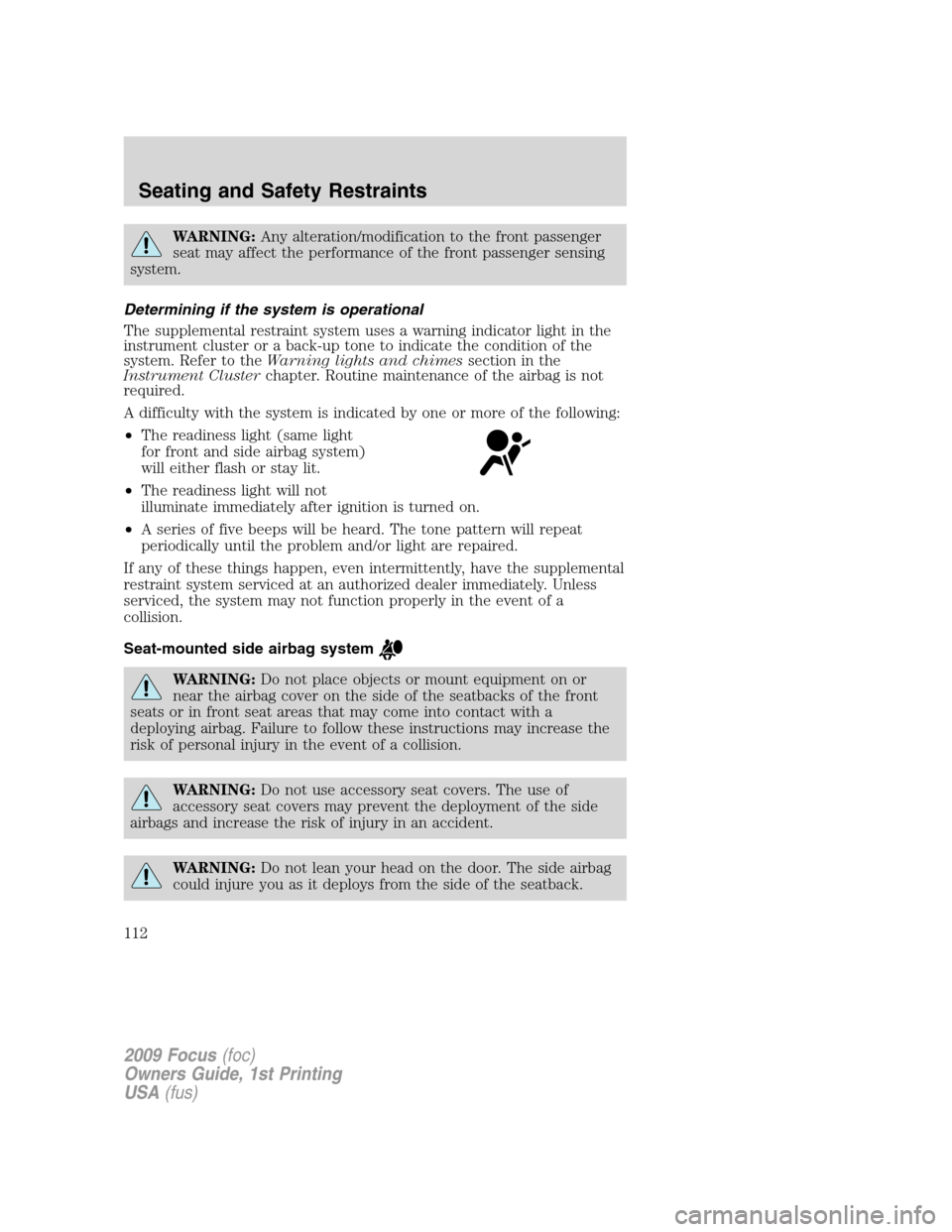
WARNING:Any alteration/modification to the front passenger
seat may affect the performance of the front passenger sensing
system.
Determining if the system is operational
The supplemental restraint system uses a warning indicator light in the
instrument cluster or a back-up tone to indicate the condition of the
system. Refer to theWarning lights and chimessection in the
Instrument Clusterchapter. Routine maintenance of the airbag is not
required.
A difficulty with the system is indicated by one or more of the following:
•The readiness light (same light
for front and side airbag system)
will either flash or stay lit.
•The readiness light will not
illuminate immediately after ignition is turned on.
•A series of five beeps will be heard. The tone pattern will repeat
periodically until the problem and/or light are repaired.
If any of these things happen, even intermittently, have the supplemental
restraint system serviced at an authorized dealer immediately. Unless
serviced, the system may not function properly in the event of a
collision.
Seat-mounted side airbag system
WARNING:Do not place objects or mount equipment on or
near the airbag cover on the side of the seatbacks of the front
seats or in front seat areas that may come into contact with a
deploying airbag. Failure to follow these instructions may increase the
risk of personal injury in the event of a collision.
WARNING:Do not use accessory seat covers. The use of
accessory seat covers may prevent the deployment of the side
airbags and increase the risk of injury in an accident.
WARNING:Do not lean your head on the door. The side airbag
could injure you as it deploys from the side of the seatback.
2009 Focus(foc)
Owners Guide, 1st Printing
USA(fus)
Seating and Safety Restraints
112
Page 157 of 276
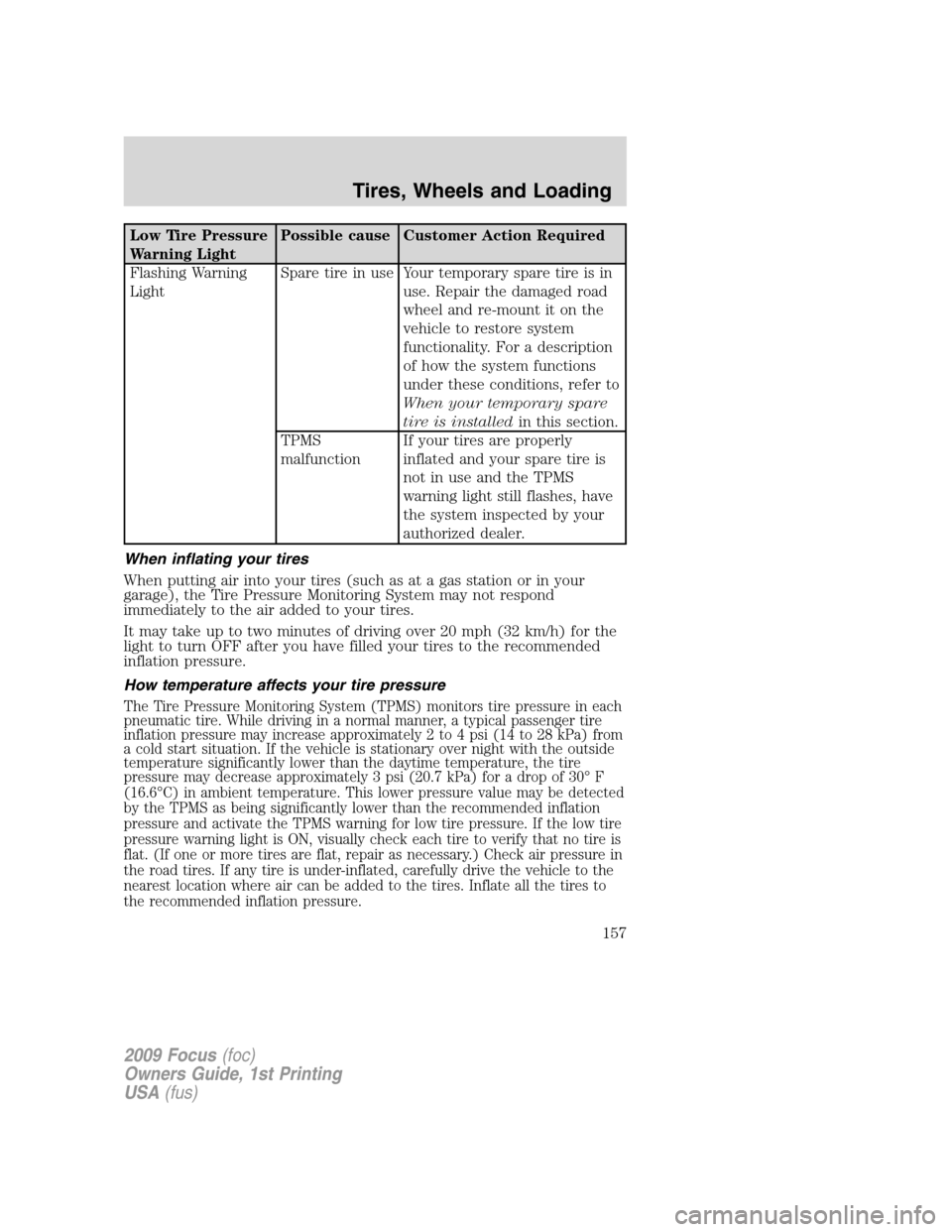
Low Tire Pressure
Warning LightPossible cause Customer Action Required
Flashing Warning
LightSpare tire in use Your temporary spare tire is in
use. Repair the damaged road
wheel and re-mount it on the
vehicle to restore system
functionality. For a description
of how the system functions
under these conditions, refer to
When your temporary spare
tire is installedin this section.
TPMS
malfunctionIf your tires are properly
inflated and your spare tire is
not in use and the TPMS
warning light still flashes, have
the system inspected by your
authorized dealer.
When inflating your tires
When putting air into your tires (such as at a gas station or in your
garage), the Tire Pressure Monitoring System may not respond
immediately to the air added to your tires.
It may take up to two minutes of driving over 20 mph (32 km/h) for the
light to turn OFF after you have filled your tires to the recommended
inflation pressure.
How temperature affects your tire pressure
The Tire Pressure Monitoring System (TPMS) monitors tire pressure in each
pneumatic tire. While driving in a normal manner, a typical passenger tire
inflation pressure may increase approximately 2 to 4 psi (14 to 28 kPa) from
a cold start situation. If the vehicle is stationary over night with the outside
temperature significantly lower than the daytime temperature, the tire
pressure may decrease approximately 3 psi (20.7 kPa) for a drop of 30° F
(16.6°C) in ambient temperature. This lower pressure value may be detected
by the TPMS as being significantly lower than the recommended inflation
pressure and activate the TPMS warning for low tire pressure. If the low tire
pressure warning light is ON, visually check each tire to verify that no tire is
flat. (If one or more tires are flat, repair as necessary.) Check air pressure in
the road tires. If any tire is under-inflated, carefully drive the vehicle to the
nearest location where air can be added to the tires. Inflate all the tires to
the recommended inflation pressure.
2009 Focus(foc)
Owners Guide, 1st Printing
USA(fus)
Tires, Wheels and Loading
157
Page 164 of 276
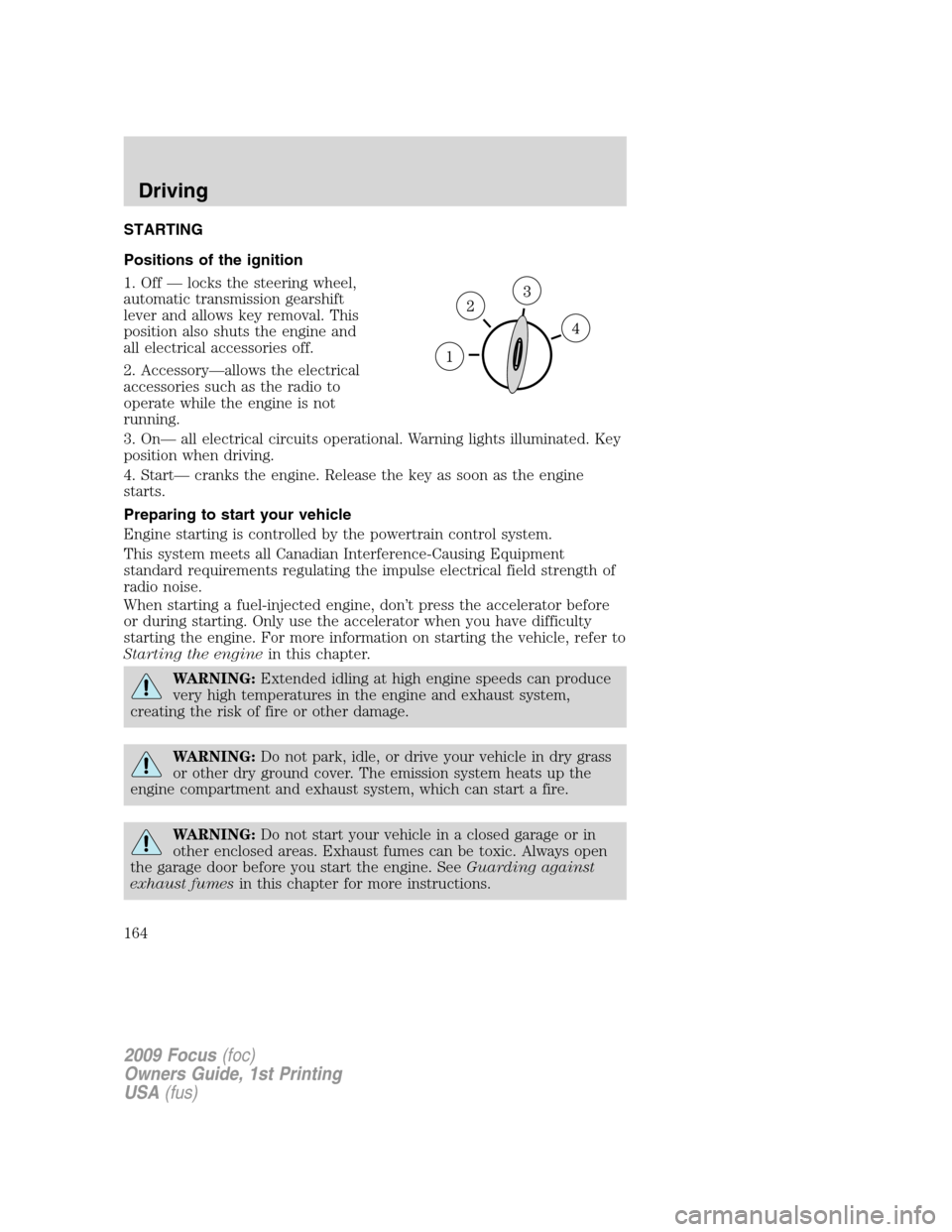
STARTING
Positions of the ignition
1. Off — locks the steering wheel,
automatic transmission gearshift
lever and allows key removal. This
position also shuts the engine and
all electrical accessories off.
2. Accessory—allows the electrical
accessories such as the radio to
operate while the engine is not
running.
3. On— all electrical circuits operational. Warning lights illuminated. Key
position when driving.
4. Start— cranks the engine. Release the key as soon as the engine
starts.
Preparing to start your vehicle
Engine starting is controlled by the powertrain control system.
This system meets all Canadian Interference-Causing Equipment
standard requirements regulating the impulse electrical field strength of
radio noise.
When starting a fuel-injected engine, don’t press the accelerator before
or during starting. Only use the accelerator when you have difficulty
starting the engine. For more information on starting the vehicle, refer to
Starting the enginein this chapter.
WARNING:Extended idling at high engine speeds can produce
very high temperatures in the engine and exhaust system,
creating the risk of fire or other damage.
WARNING:Do not park, idle, or drive your vehicle in dry grass
or other dry ground cover. The emission system heats up the
engine compartment and exhaust system, which can start a fire.
WARNING:Do not start your vehicle in a closed garage or in
other enclosed areas. Exhaust fumes can be toxic. Always open
the garage door before you start the engine. SeeGuarding against
exhaust fumesin this chapter for more instructions.
2009 Focus(foc)
Owners Guide, 1st Printing
USA(fus)
Driving
164
Page 166 of 276
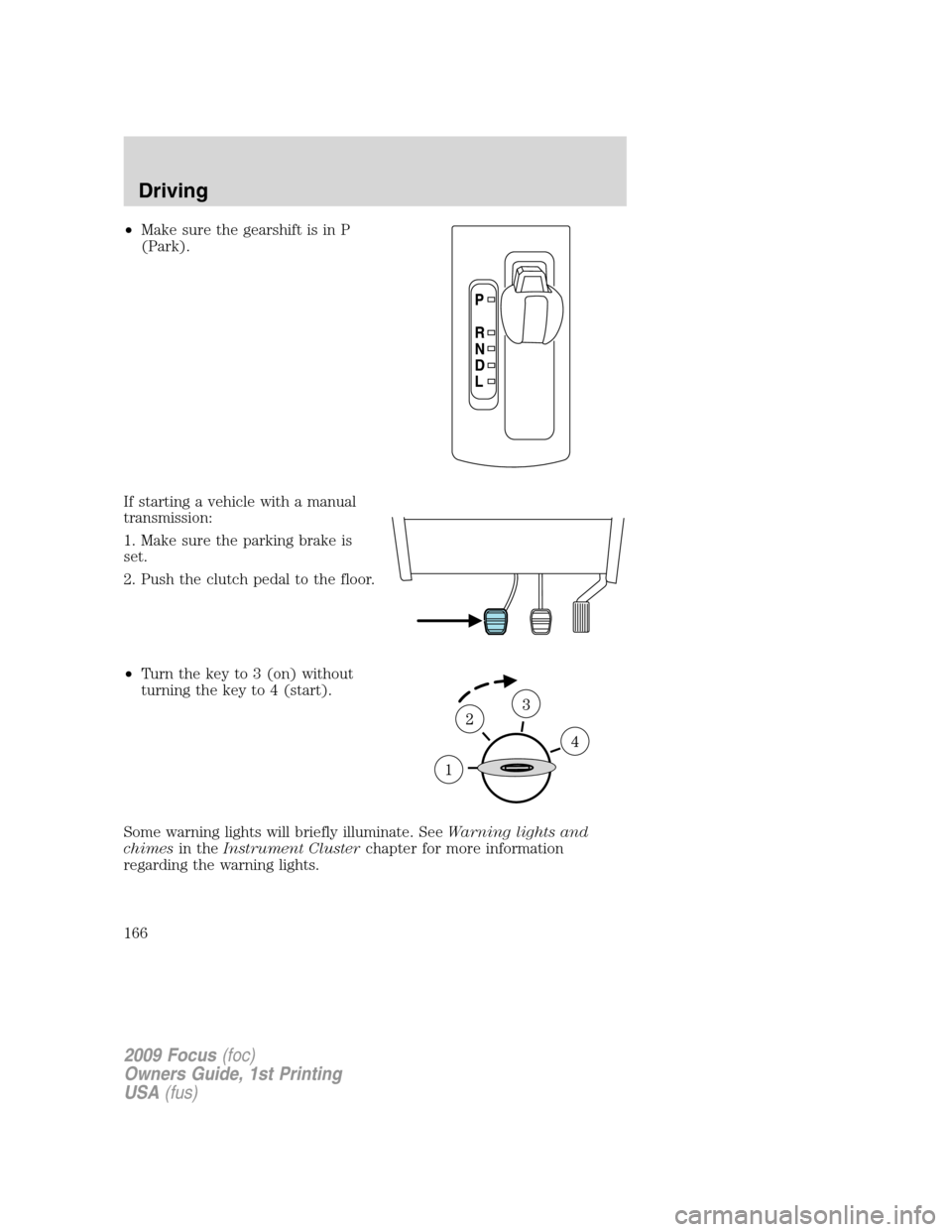
•Make sure the gearshift is in P
(Park).
If starting a vehicle with a manual
transmission:
1. Make sure the parking brake is
set.
2. Push the clutch pedal to the floor.
•Turn the key to 3 (on) without
turning the key to 4 (start).
Some warning lights will briefly illuminate. SeeWarning lights and
chimesin theInstrument Clusterchapter for more information
regarding the warning lights.
2009 Focus(foc)
Owners Guide, 1st Printing
USA(fus)
Driving
166
Page 200 of 276
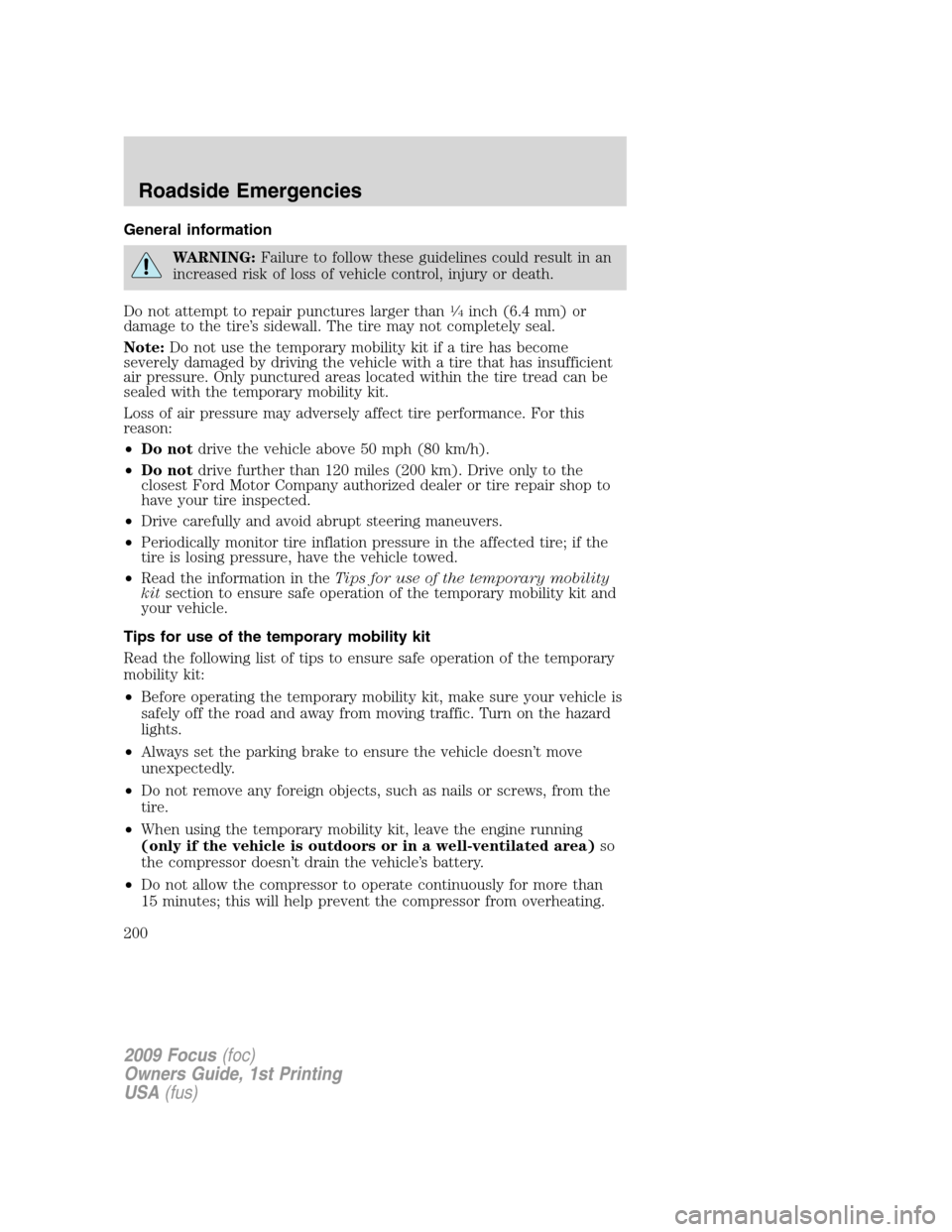
General information
WARNING:Failure to follow these guidelines could result in an
increased risk of loss of vehicle control, injury or death.
Do not attempt to repair punctures larger than
1�4inch (6.4 mm) or
damage to the tire’s sidewall. The tire may not completely seal.
Note:Do not use the temporary mobility kit if a tire has become
severely damaged by driving the vehicle with a tire that has insufficient
air pressure. Only punctured areas located within the tire tread can be
sealed with the temporary mobility kit.
Loss of air pressure may adversely affect tire performance. For this
reason:
•Do notdrive the vehicle above 50 mph (80 km/h).
•Do notdrive further than 120 miles (200 km). Drive only to the
closest Ford Motor Company authorized dealer or tire repair shop to
have your tire inspected.
•Drive carefully and avoid abrupt steering maneuvers.
•Periodically monitor tire inflation pressure in the affected tire; if the
tire is losing pressure, have the vehicle towed.
•Read the information in theTips for use of the temporary mobility
kitsection to ensure safe operation of the temporary mobility kit and
your vehicle.
Tips for use of the temporary mobility kit
Read the following list of tips to ensure safe operation of the temporary
mobility kit:
•Before operating the temporary mobility kit, make sure your vehicle is
safely off the road and away from moving traffic. Turn on the hazard
lights.
•Always set the parking brake to ensure the vehicle doesn’t move
unexpectedly.
•Do not remove any foreign objects, such as nails or screws, from the
tire.
•When using the temporary mobility kit, leave the engine running
(only if the vehicle is outdoors or in a well-ventilated area)so
the compressor doesn’t drain the vehicle’s battery.
•Do not allow the compressor to operate continuously for more than
15 minutes; this will help prevent the compressor from overheating.
2009 Focus(foc)
Owners Guide, 1st Printing
USA(fus)
Roadside Emergencies
200
Page 251 of 276
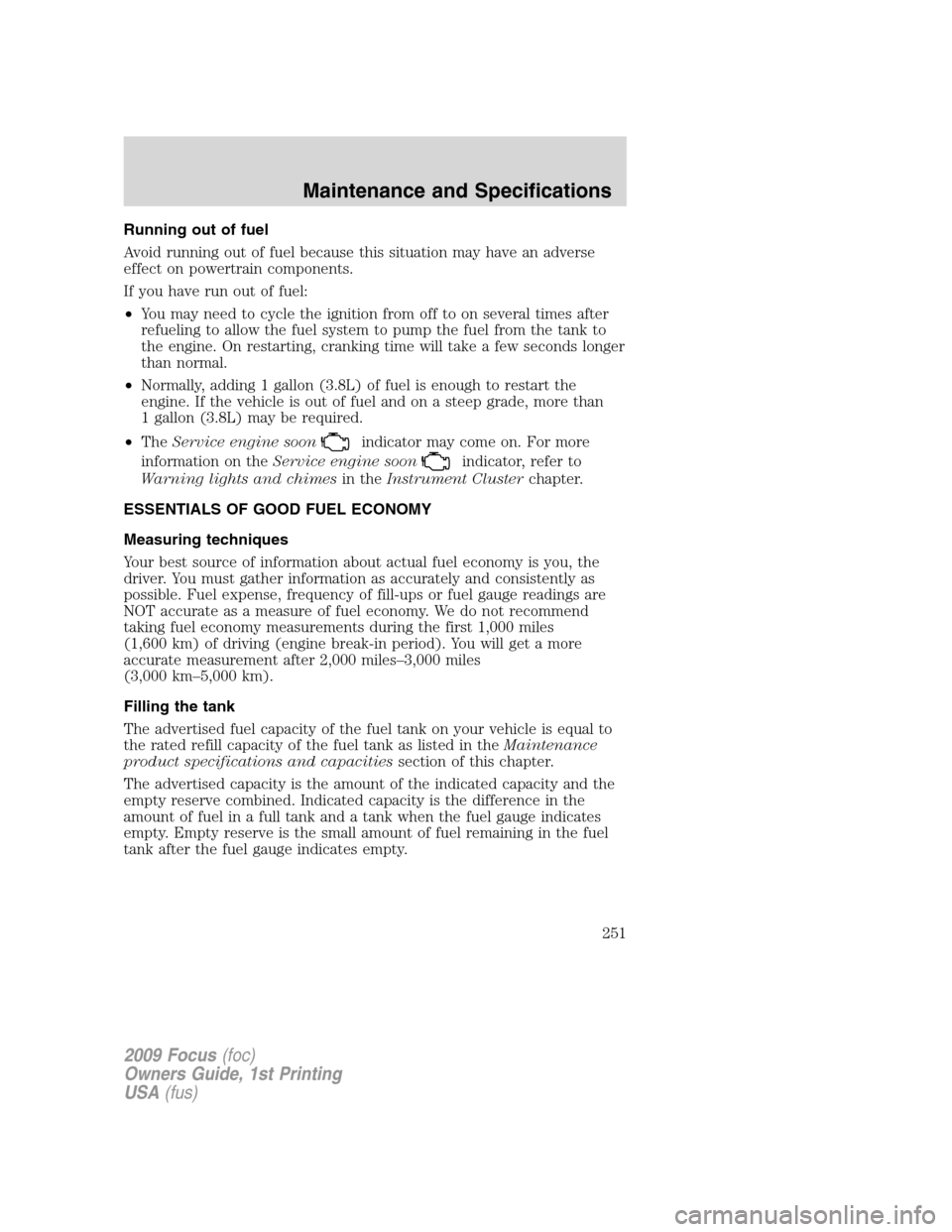
Running out of fuel
Avoid running out of fuel because this situation may have an adverse
effect on powertrain components.
If you have run out of fuel:
•You may need to cycle the ignition from off to on several times after
refueling to allow the fuel system to pump the fuel from the tank to
the engine. On restarting, cranking time will take a few seconds longer
than normal.
•Normally, adding 1 gallon (3.8L) of fuel is enough to restart the
engine. If the vehicle is out of fuel and on a steep grade, more than
1 gallon (3.8L) may be required.
•TheService engine soon
indicator may come on. For more
information on theService engine soon
indicator, refer to
Warning lights and chimesin theInstrument Clusterchapter.
ESSENTIALS OF GOOD FUEL ECONOMY
Measuring techniques
Your best source of information about actual fuel economy is you, the
driver. You must gather information as accurately and consistently as
possible. Fuel expense, frequency of fill-ups or fuel gauge readings are
NOT accurate as a measure of fuel economy. We do not recommend
taking fuel economy measurements during the first 1,000 miles
(1,600 km) of driving (engine break-in period). You will get a more
accurate measurement after 2,000 miles–3,000 miles
(3,000 km–5,000 km).
Filling the tank
The advertised fuel capacity of the fuel tank on your vehicle is equal to
the rated refill capacity of the fuel tank as listed in theMaintenance
product specifications and capacitiessection of this chapter.
The advertised capacity is the amount of the indicated capacity and the
empty reserve combined. Indicated capacity is the difference in the
amount of fuel in a full tank and a tank when the fuel gauge indicates
empty. Empty reserve is the small amount of fuel remaining in the fuel
tank after the fuel gauge indicates empty.
2009 Focus(foc)
Owners Guide, 1st Printing
USA(fus)
Maintenance and Specifications
251
Page 274 of 276

headlamps, flash to pass ..........42
instrument panel, dimming .....42
interior lamps .....................44, 46
replacing bulbs .........................46
LATCH anchors .........................129
Lights, warning and indicator ....12
anti-lock brakes (ABS) ..........170
Load limits .................................158
Locks
autolock .....................................68
childproof ..................................72
doors ..........................................68
Lubricant specifications ...........263
Lug nuts ....................................208
M
Manual transaxle
lubricant specifications ..........263
Manual transmission .................181
fluid capacities ........................263
reverse .....................................182
Message center ...........................61
english/metric button ...............64
system check button ................63
warning messages .....................65
Mirrors ...................................53–54
automatic dimming rearview
mirror ........................................54
heated ........................................55
side view mirrors (power) .......54
Moon roof ....................................59
Motorcraft parts ........230, 246, 261
O
Octane rating ............................250
Oil (see Engine oil) ..................236P
Parking brake ............................171
Parts (see Motorcraft parts) ....261
Passenger Occupant
Classification Sensor ...................90
Power distribution box
(see Fuses) ...............................190
Power door locks ........................68
Power mirrors .............................54
Power point .................................51
Power steering ..........................177
fluid, checking and adding ....257
fluid, refill capacity ................263
fluid, specifications .................263
Power Windows ...........................52
R
Radio ............................................20
Recommendations for
attaching safety restraints for
children ......................................121
Relays ........................................186
Remote entry system .................74
locking/unlocking doors .....74–75
opening the trunk .....................75
panic alarm ...............................75
replacement/additional
transmitters ...............................76
replacing the batteries .............76
Roadside assistance ..................184
S
Safety belts (see Safety
restraints) ........................89, 92–97
Safety Canopy ...........................112
2009 Focus(foc)
Owners Guide, 1st Printing
USA(fus)
Index
274
Page 276 of 276

Trunk ...........................................72
remote release ..........................75
Turn signal ..................................44
U
USB port ......................................30
V
Vehicle Identification Number
(VIN) ..........................................267
Vehicle loading ..........................158
Ventilating your vehicle ...........167W
Warning lights (see Lights) .......12
Washer fluid ..............................235
Water, Driving through .............183
Windows
power .........................................52
Windshield washer fluid and
wipers ..........................................50
checking and adding fluid .....235
replacing wiper blades ...........235
Wrecker towing .........................214
2009 Focus(foc)
Owners Guide, 1st Printing
USA(fus)
Index
276